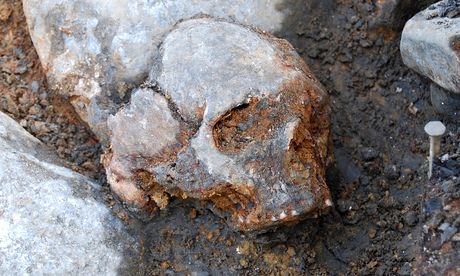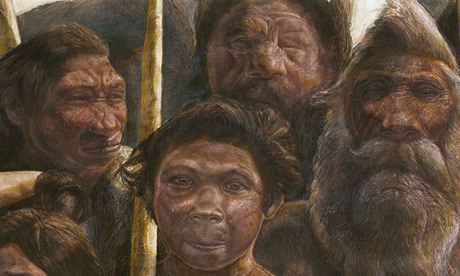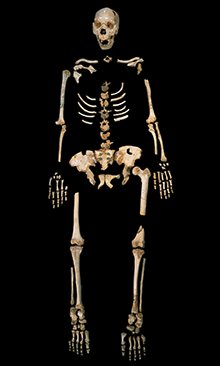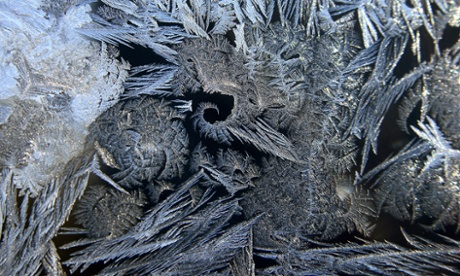Amber Larson, Crystal Quintero, Wisdom Quarterly; Ian Sample (theguardian.com, 9-18-14)
 |
| The cranium of a female hunter-gatherer found in Kanaljorden, Sweden. Research suggests all modern Europeans have hunter-gatherer and early farmer DNA (Fredrik Hallgren/GDN). |
DNA study reveals third group of ancient ancestors of modern Europeans
 |
| Human origins? (mcremo.com) |
Mixture of hunter-gatherers and farmers was augmented by third wave of migrants, perhaps 5,000 years ago, from north Eurasia.
The first Homo sapiens arrived in Europe about 45,000 years ago, and these hunter-gatherers were replaced by early farmers who brought agriculture to the continent more than 7,000 years ago from Anatolia and the Levant in the Near East.
The arrival of the first farmers set the stage for Europeans to be the descendants of the agriculturalists and indigenous hunter-gatherers, but genetic studies found that a piece of the puzzle was missing: some European DNA came from elsewhere.
- Ancient Chinese cat bones shake up domestication theory Fossil discovery an "important step" in how feline transformation from pest-control to pet
- Discovery of oldest human DNA in Spanish cave sheds light on evolution
- Worm's jawbone: how a zoological curiosity became a historical treasure

To clear up the mystery, researchers in Germany and the US sequenced the full genetic code of nine ancient humans. Among them were a 7,000-year-old farmer from Germany and 7,000- to 8,000-year-old hunter-gatherers from Luxembourg and Sweden. The scientists then compared these genomes with DNA taken from more than 2,000 modern-day people from all over the world and with other ancient genomes.
 |
| Good science, bad assumptions |
They found that nearly all modern Europeans had a mixture of western European hunter-gatherer and early European farmer DNA, but with a good measure of ancient north Eurasian ancestry thrown in.
The north Eurasian DNA was identified from the 24,000-year-old remains of a young boy buried at Mal'ta near Lake Baikal in eastern Siberia.
"It became very clear that all Europeans have hunter-gatherer as well as early farmer DNA to varying degrees, but it was also very clear that something was missing here in the makeup of modern Europeans," said Johannes Krause, at the University of Tübingen's Institute for Archaeological Sciences.
The findings suggest that the arrival of modern humans into Europe more than 40,000 years ago was followed by an influx of farmers some 8,000 years ago, with a third wave of migrants coming from north Eurasia perhaps 5,000 years ago. Others from the same population of north Eurasians took off towards the Americas and gave rise to Native Americans.
Modern Europeans are various mixes of the three populations. More
- Astronomy Photographer of the Year 2014 - in pictures
- Ig Nobels: Brit researchers take science humor prize
- Artificial sweeteners = diabetes, claim scientists
- Pot use in teens, suicide, school dropout: jury still out
- Faith and Wisdom in Science by Tom McLeish, review – rich and discursive
- Comments, comets and cannabis - blogs roundup
- More most viewed
- Science - Genetics - Anthropology - More
Discovery of oldest human DNA in Spanish cave sheds light on evolution
Ian Sample (The Guardian, Dec. 4, 2013)
 |
| Artist's impression of humans estimated to have lived 400K years ago (Kennis & Kennis/AP). |
 |
| DNA found in thigh bone (Javier Trueba/AP) |
Scientists say DNA strands in thigh bone of 400,000-year-old early human can help build clearer picture of human family tree.
Researchers have read strands of ancient DNA teased from the thigh bone of an early human who died 400,000 years ago in what is now northern Spain.
The genetic material was pieced together from a clutch of cells found in bone fragments -- the oldest human remains ever to yield their genetic code.
The work deepens understanding of the genetics of human evolution by about 200,000 years, raising hopes that researchers can build a clearer picture of the earliest branches of the human family tree by studying the genetic make-up of fossilized remains dug up elsewhere.
"This is proof of principle that it can be done," said Matthias Meyer at the Max Planck Institute for Evolutionary Anthropology in Leipzig. "We are now very eager to explore other sites of a similar age."





















































































































































































































































No comments:
Post a Comment